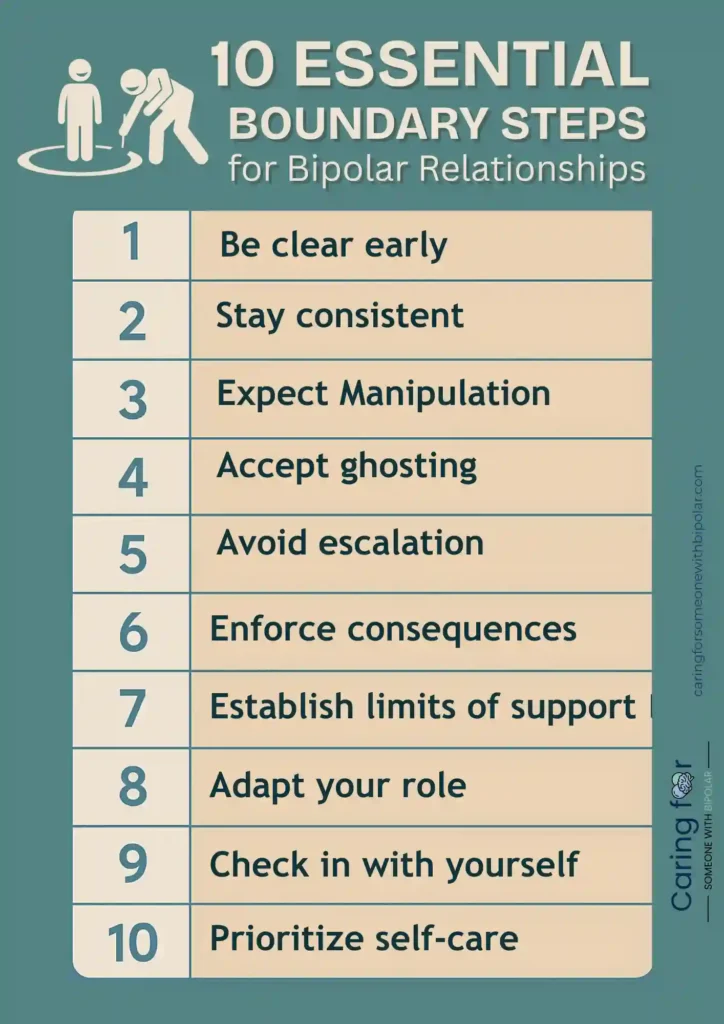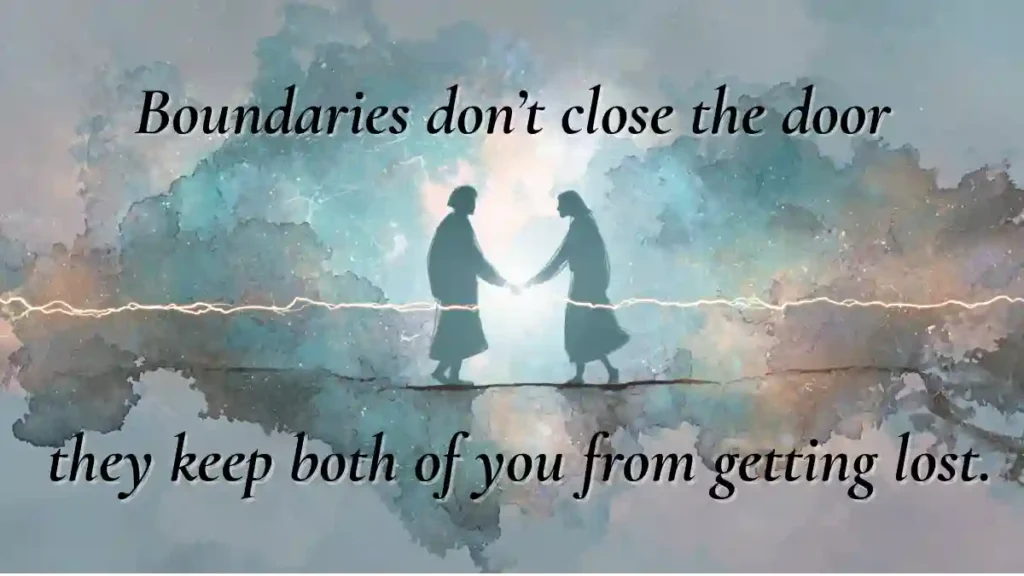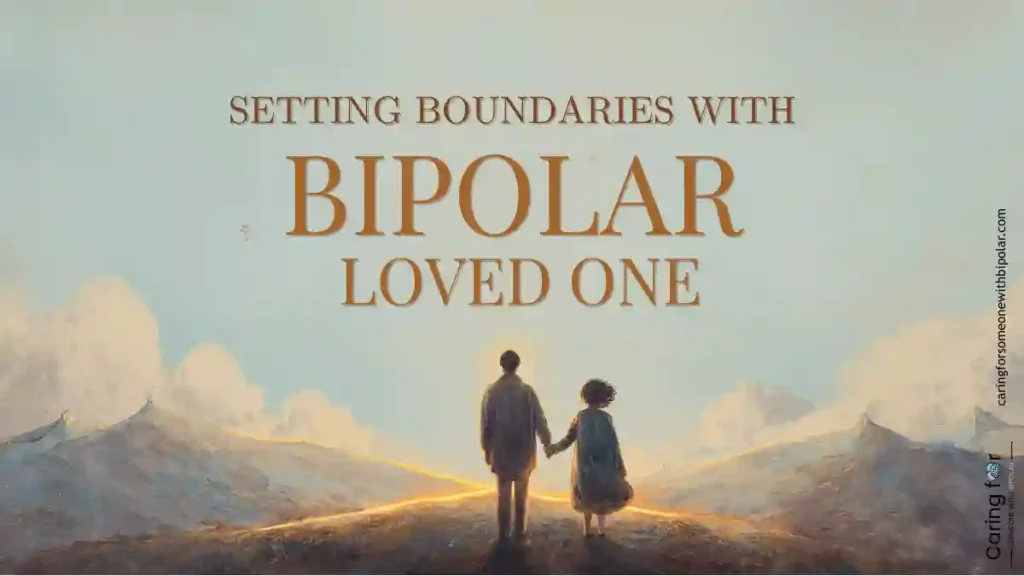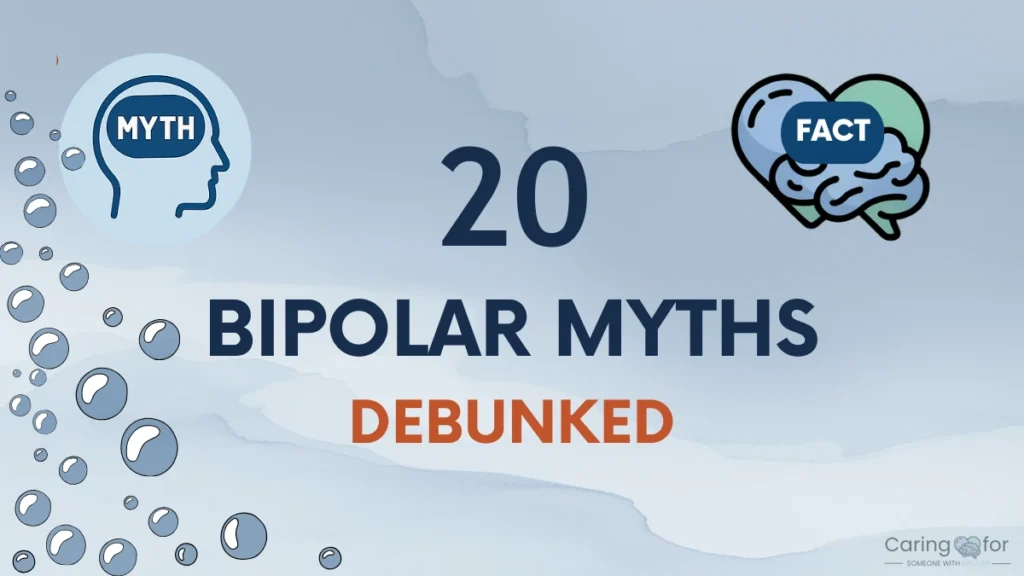Let’s be honest, loving someone with bipolar disorder can feel like running on emotional fumes. One day you’re offering comfort, the next you’re absorbing verbal fire, and somewhere in the middle, your own needs start vanishing. You might even wonder, “Am I being selfish… or just surviving?”
That’s not a small question. When boundaries are blurry, it’s not just the relationship that suffers, it’s your sense of self. And if you’ve landed here, chances are you’re not looking to abandon your loved one. You’re looking to stay present without getting pulled under. You want tools, not theories.
This guide gives you exactly that.
You’ll learn 10 essential, compassionate ways to set boundaries with someone who has bipolar disorder, whether they’re a partner, parent, friend, or colleague. And not just surface-level advice. We’ll dig into real scripts, lived experiences, crisis cues, and subtle red flags most articles ignore.
Because here’s the truth: boundaries aren’t a betrayal. They’re the quiet way we say, “I love you, and I love me too.”

Why Boundaries Are a Form of Love
At first glance, the word “boundary” might feel harsh, like a wall you build to keep someone out. But in relationships shaped by bipolar disorder, boundaries aren’t barricades. They’re the opposite: they’re anchors. And without them, everything, trust, safety, even love, starts drifting.
When “Helping” Starts to Hurt
It often begins with the best intentions. You stay up all night talking someone down from a spiral. When they’re having a rough day, you cancel your plans without hesitation. The anger, the silence, the chaos, you excuse it all, because “they’re struggling.”
But somewhere along the way, your own energy gets depleted. Your needs vanish under the weight of crisis management. And you start noticing it in your body: irritability, exhaustion, resentment. You’re not just tired, you’re disappearing.
That’s not care. That’s emotional erosion.
Setting boundaries doesn’t mean you love them less. It means you’ve learned that real connection can’t grow where one person is always overextending and the other doesn’t know where the lines are.
Boundaries Make Room for Respect
In relationships touched by mental illness, especially one as mood-variable as bipolar disorder, respect can unintentionally erode. Not out of malice, but because the emotional terrain keeps shifting. One moment your loved one is affectionate, lucid, present. The next, they’re irritable, impulsive, or distant.
Without consistent boundaries, those shifts can breed instability and emotional chaos.
What boundaries do is steady the ground beneath you both. They teach your loved one what’s okay, what’s not, and when it’s time to seek help beyond you. More importantly, they protect the space where trust and mutual respect can grow, even when moods don’t cooperate.
Why do I feel guilty setting boundaries?
It’s common to feel like you’re abandoning someone when you pull back. But guilt often masks fear: fear that if you assert your needs, the relationship will break. Here’s the twist, without boundaries, it likely will.
By setting limits with love and consistency, you’re giving the relationship a chance to thrive without becoming destructive to either of you.
How Bipolar Disorder Impacts Relationships
Bipolar disorder isn’t just about mood swings, it’s about emotional weather systems that can change rapidly, leaving loved ones feeling like they’re living without shelter. And when you’re close to someone navigating bipolar, those shifts don’t stay neatly contained. They crash into your routines, your expectations, your peace.
Understanding these patterns is key to setting boundaries that are fair, realistic, and compassionate, not reactive or punitive.
The Emotional Spectrum of Bipolar
Most people know bipolar disorder as a cycle between highs and lows. But the reality is more nuanced:
- Mania: Characterized by elevated mood, high energy, grandiose thinking, impulsivity. Conversations may feel fast and intense, plans unrealistic, and limits hard to enforce.
- Hypomania: Similar to mania but milder. It can look like productivity, confidence, or charm, until it tips into risky behavior.
- Depression: Deep sadness, withdrawal, fatigue, hopelessness. Often leads to “ghosting,” loss of interest, or even aggressive apathy.
Each of these phases can challenge your ability to maintain boundaries because they tap into different emotional hooks, urgency, guilt, worry, or even hope that “this time it’s different.”
The Relationship Patterns That Emerge
Here’s what often happens when boundaries are unclear or inconsistently enforced in bipolar relationships:
- Emotional Whiplash: You feel confused or off-balance, never knowing which version of your loved one will show up.
- Over-functioning: You step into a caregiver role, even when you’re the partner, friend, or coworker.
- Unintentional Manipulation: Mood-driven behaviors (guilt-tripping, gaslighting, threats of withdrawal) take root, not from cruelty, but from dysregulation.
- Internalized Shame: When they stabilize, your loved one may feel remorse, but without boundaries, nothing changes long term.
Recognizing that these aren’t character flaws, but symptoms, is crucial. But that doesn’t mean you excuse them endlessly. It means you acknowledge the disorder, and still assert your right to emotional safety.
How do bipolar symptoms affect relationship dynamics?
Bipolar symptoms often intensify emotional intensity and unpredictability in relationships. This can lead to codependency, communication breakdowns, and blurred roles unless boundaries are actively defined and reinforced.
10 Steps to Set Boundaries with a Bipolar Person
Healthy boundaries don’t just protect you. They guide the relationship through moments of chaos, uncertainty, and recovery. These ten steps aren’t about controlling your loved one. They’re about holding steady when moods shift, and creating a space where respect can exist alongside compassion.
Each one is practical, grounded in real dynamics, and backed by what many caregivers and partners have learned the hard way.
1. Communicate Boundaries Early and Clearly
Boundaries set during calm moments are easier to respect and understand. Waiting until tensions are high often makes them feel like punishments rather than agreements.
What to say:
“I’m here for you, but I can’t be on call at all hours. Let’s check in after I’ve had some rest.”
2. Stay Consistent, Regardless of Their Mood
It’s tempting to loosen boundaries during manic or depressive episodes. But inconsistency teaches your loved one that your limits shift with their emotions.
What to say:
“I know this feels urgent, but I won’t continue this conversation unless we’re both calm.”
3. Recognize and Defuse Manipulation Patterns
Mood episodes can trigger guilt trips, dramatic ultimatums, or passive-aggressive behaviors. These patterns may not be intentional, but they are still impactful.
What to say:
“I care about you, and I need to step away so I don’t say something I’ll regret.”
4. Don’t Chase During “Ghosting” Phases
Disappearing during depressive episodes is common. It’s often a sign of inner collapse, not rejection. Resist the urge to over-pursue or internalize it.
What to say:
“I noticed you’ve pulled back. I’m still here if you want to talk when you’re ready.”
5. Protect Peace During Arguments
Trying to argue with someone mid-episode often escalates things. Walking away isn’t weakness. It’s wisdom.
What to say:
“I’m stepping away until we’re both calm enough to talk. I want this to be respectful.”
6. Respond Firmly When Boundaries Are Ignored
If the same line keeps getting crossed, it’s no longer a misunderstanding. It’s a pattern that needs consequences.
What to say:
“I’ve asked for space several times. Since that hasn’t been respected, I’m pausing communication for now.”
7. Know When Outside Help Is Needed
There’s a line between support and responsibility. You can’t manage suicidal thoughts, threats, or violence on your own. Know when to escalate.
What to say:
“I care deeply, but this is bigger than both of us. I’m calling someone who can help you safely.”
8. Match Boundaries to the Role You Play
What works with a friend might not work with a partner or coworker. Adjust your expectations and limits accordingly.
Examples:
- Friend: “Let’s check in weekly, not daily.”
- Partner: “Let’s make a plan for what happens during mood shifts.”
- Coworker: “Let’s keep things task-focused at work.”
- Parent/Child: “I’ll support you, but I won’t enable risky behavior.”
9. Watch for Signs of Your Own Burnout
Resentment, emotional fatigue, or numbness are signs that your needs are slipping too far out of view.
What to remind yourself:
“I’m allowed to take a step back without being a bad person.”
10. Prioritize Your Mental Health Too
Supporting someone long-term requires tending to your own peace with equal care. Boundaries aren’t just about them. They’re about you surviving, and healing, too.
Helpful actions:
- Join a support group (like NAMI Family Support)
- Go to therapy
- Take breaks without guilt
- Say no without a long explanation
Can I really set boundaries without making things worse?
Yes. In fact, boundaries often make things better in the long run. They reduce chaos, increase trust, and show that your love has structure. Even if met with resistance at first, they create a foundation for mutual safety and respect.
Real-Life Scenarios and How to Respond
Sometimes, theory isn’t enough. You need the words, especially in emotionally charged moments. Below are real situations people face when navigating bipolar relationships, with supportive scripts to help you respond firmly yet compassionately.
Scenario 1: “My bipolar friend is exhausting, how do I protect my energy?”
Context: You love your friend, but they constantly vent, spiral, or call during emotional crises, leaving you drained.
What to Say:
“I care about you so much, and I also need time to recharge. Can we check in tomorrow when I’ve had time to rest?”
Scenario 2: “My partner lashes out during manic episodes. I feel disrespected.”
Context: You’re stuck in verbal confrontations and don’t know how to set boundaries without triggering more anger.
What to Say:
“I understand you’re feeling intense right now, but I can’t continue this conversation unless we’re both calm. I’m stepping away for now.”
Scenario 3: “My bipolar daughter keeps pushing boundaries, then apologizes later.”
Context: She may act out during episodes and say hurtful things, only to express remorse once stable.
What to Say:
“I appreciate your apology. I still need us to talk about how we’ll handle this behavior if it happens again. Let’s plan for it together.”
Scenario 4: “My bipolar coworker’s mood swings affect our work, but I feel awkward saying anything.”
Context: Their highs and lows disrupt team flow, and you’re not sure how to express your concerns professionally.
What to Say:
“I’ve noticed some emotional tension lately, and I think it’s affecting our collaboration. Can we agree to keep communication focused and respectful during the workday?”
Scenario 5: “They ghosted me again after I reached out to help.”
Context: You feel abandoned or confused when they disappear during depressive episodes.
What to Say (later):
“I understand you needed space. I’m here if you ever want to talk, but I also need clarity on how we stay connected.”
Myths, Mistakes, and Traps to Avoid
When someone you love has bipolar disorder, the instinct to help can override everything else, including your own judgment. That’s where myths creep in and mistakes happen. And while your heart may be in the right place, unexamined assumptions can turn your compassion into codependency.
This section is about naming those traps so you can sidestep them before they erode your sanity or your relationship.
Myth: “Tough love is the only thing that works.”
This idea gets repeated a lot. But “tough love” often translates to ultimatums, cold detachment, or threats, all of which can trigger shame or panic, especially during depressive or manic episodes.
What works better:
Compassionate firmness. Clear boundaries paired with kindness. Saying no, not out of punishment, but because your peace matters too.
Try this instead:
“I can’t fix this for you, but I’ll stay beside you while you find your way through.”
Mistake: Trying to “Fix” or “Save” Them
This one is subtle. You mean well, you want to protect them from their worst moments. But when you become the therapist, the crisis line, and the safety net all in one, two things happen: you burn out, and they never build their own support structure.
What to do instead:
Encourage professional help. Trust in their resilience. And model emotional steadiness, not over-responsibility.
Say this:
“I’m here to support you, but I can’t be your only source of help. Have you talked to your therapist about this?”
Trap: Minimizing Your Own Needs
Sometimes, boundaries are hard to assert because your inner dialogue says things like, “They have it worse,” or “I should be stronger.” But chronic emotional neglect, especially of yourself, doesn’t lead to healing. It leads to quiet resentment.
What to remember:
Your needs are valid, even if someone else is struggling more visibly. You don’t have to be a martyr to be loving.
Can boundaries really coexist with empathy?
Absolutely. In fact, boundaries require empathy. They’re not about pushing someone away. They’re about staying close in ways that don’t destroy you both. Real empathy says, “I care enough to be honest, and I respect both of us enough to set limits.”
When Boundaries Aren’t Enough: Recognizing Crisis Signs
Sometimes, no matter how clear or compassionate your boundaries are, things escalate. Not because you failed, but because the situation is bigger than what love, patience, or personal limits can hold. This is where support has to shift, from you to professionals.
It’s not disloyal to reach out for help. It’s often the most loving and responsible move you can make.
Know the Red Flags
There’s a critical difference between emotional distress and true crisis. If you’re seeing any of the following, it’s time to act:
- Threats of self-harm or suicide
- Physical violence or intimidation
- Escalating delusions or paranoia
- Total emotional shutdown with refusal to eat, speak, or care for themselves
- Repeated violations of safety boundaries, like showing up uninvited or calling nonstop
When these signs appear, your role shifts from supporter to safety advocate.
What Taking Action Can Look Like
You don’t have to manage this alone. You can call a crisis line, involve a mental health professional, or even contact emergency services if someone’s life is at risk.
What to say:
“I care about you, and I know this feels overwhelming. But I can’t keep you safe on my own. I’m calling someone who can help.”
That one sentence can feel terrifying. But when the alternative is watching someone spiral unchecked, it becomes necessary.
Will they hate me for calling for help?
Maybe, in the moment. Especially if they’re manic or detached. But over time, many people come to understand that those who intervened were doing it out of care, not control. And if they don’t see it that way, it doesn’t mean you were wrong. It means they’re still in it. Your job isn’t to be liked in a crisis. It’s to keep people safe, including yourself.
Expert and Survivor Insights
Sometimes, what shifts your perspective isn’t advice. It’s hearing someone else put your exact feelings into words, especially someone who’s lived it, or guided others through it. In this section, we’re not handing down theories. We’re surfacing the wisdom of people who’ve been in the thick of bipolar dynamics and lived to tell it honestly.
Professional Reflections
“Boundaries aren’t about withdrawal. They’re about creating space where two people’s mental health can safely coexist.”
— Dr. Rachel Wynn, Clinical Psychologist, specializing in mood disorders
“When families learn to set limits with love, they stop rescuing and start relating again. That’s when healing begins.”
— Karen DuMont, LCSW, Family Therapist and crisis counselor
Lived Experience
“When I was manic, I hated hearing ‘no.’ But during recovery, I realized the people who set boundaries were the ones who didn’t abandon me. They were the ones I trusted most.”
— Janelle M., diagnosed with Bipolar I
“Being the strong one for my bipolar brother nearly broke me. Therapy helped me realize I didn’t have to carry both our lives.”
— Luis R., sibling and long-term caregiver
“I thought saying yes to everything was love. Turns out, love got clearer when I finally said no.”
— Tanya P., partner of someone with Bipolar II
These stories don’t promise happy endings or perfect outcomes. They’re proof that boundaries can coexist with love, pain, hope, and recovery – all at once.
Should I share this article with someone who has bipolar disorder?
If it’s done respectfully and with context, yes. It can open up dialogue about mutual needs, not just yours. But timing matters. Share it during a calm window, not during a conflict. And be clear: this isn’t a demand, it’s an invitation to understand each other better.
Further Support and Resources
No matter how strong your boundaries are, no one should navigate this entirely alone. If you’re supporting someone with bipolar disorder – especially over the long haul – having trusted tools, community, and crisis help in your back pocket isn’t optional. It’s vital.
Below are curated resources that offer everything from peer support to professional guidance.
Recommended Reading and Internal Articles
- Understanding Bipolar Episodes: What to Expect and How to Support (coming soon)
- How to Manage Bipolar Anger Without Losing Yourself (coming soon)
- 10 Signs You Might Be Enabling (Not Supporting) a Loved One (coming soon)
- Burnout in Caregivers: How to Spot It and What to Do (coming soon)
- When Your Bipolar Friend Ghosts You: What It Really Means (coming soon)
Trusted External Resources
- National Alliance on Mental Illness (NAMI) — Education, support groups, crisis navigation
- Mental Health America — Screenings, factsheets, treatment help
- Crisis Text Line — Free, 24/7 support via text (Text HOME to 741741)
- Suicide & Crisis Lifeline (24/7, free, confidential) — Immediate support by phone (988) in the U.S.
- Befrienders Worldwide — Global suicide hotline directory
Where should I start if I feel overwhelmed?
Start small. Bookmark this page. Text “HOME” to 741741 if you’re in emotional crisis. Find one support group – online or local – and attend. Or simply set one boundary today and stick with it. Momentum grows when you act, not when you wait to feel ready.
Final Thoughts: Boundaries Aren’t a Wall – They’re a Bridge
Let’s face it. Loving someone with bipolar disorder often means living in tension between your instincts to help and your need to survive. It’s messy, brave, and exhausting. But it doesn’t have to mean losing yourself.
Setting boundaries isn’t cold. It’s clarity. It’s you saying, “I want this connection – but not at the cost of my peace.” That’s not cruelty. That’s maturity. And it’s the only kind of love that can actually last through the storms this disorder sometimes brings.
If this guide gave you even a little more clarity, please don’t keep it to yourself. Share it with someone navigating the same terrain. Use the scripts. Reread the hard parts. Start messy if you must. But start.
Because boundaries, when done right, don’t shut doors. They hold them open – in a way that no one gets crushed in the process.

Frequently Asked Questions
Last Updated
Reviewed by Dr. Linda Shaw, PhD – Clinical Psychologist
Last updated: July 2025
Know Your Personal Red Flags
If you’re experiencing:
- Constant fear or anxiety around your loved one
- Signs of emotional manipulation or gaslighting
- Isolation from other support systems
- Physical threats or intimidation
…it’s not just about boundaries anymore, it’s about safety.
You are allowed to walk away from unsafe dynamics, even if the person is struggling with mental illness.
Let’s Keep the Conversation Going
If this article helped you, please consider:
- Sharing your story in the comments , others may need your voice.
- Sending this to a friend or loved one navigating a similar dynamic.
- Subscribing to our updates for more tools on mental health, relationships, and resilience.
- Discover our 15 Practical Ways to Support a Loved One with Bipolar Disorder





